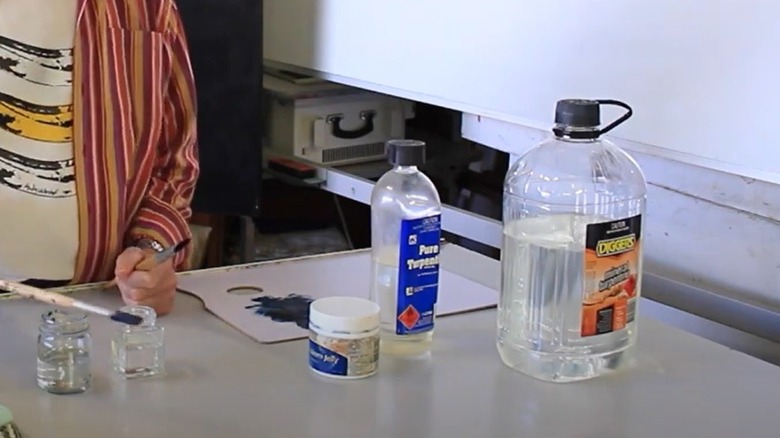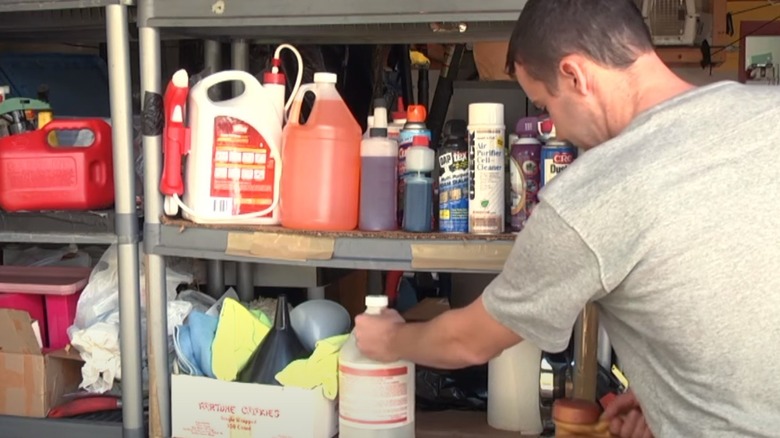Here's How To Store Paint Thinner The Right Way
Removing dry paint from brushes can be a challenge, which is why people sometimes deploy paint thinner solvents to simplify the process of cleaning up afterward. These solvents, which can include products like turpentine, acetone, and xylene, combine several different liquid chemicals, which means they can have some volatility when being stored. When it's time to store the paint thinner, the most important step is to tightly secure the lid on the container. You also should try to leave the material inside the original container it shipped in, which usually is metal. Keep the metal can high on a shelf, where children cannot reach it. Keep it away from sources of heat, like a furnace. Always try to store these solvents in a cool, dry place with some airflow and away from other chemicals.
In addition to storing a can of this product safely, you need to properly dispose of any rags that contain paint thinner. Such rags are potentially flammable, so you should take care of them immediately. You can use an empty paint can. Place the rags inside and then tap the lid tightly shut. You do not want to keep these rags inside the home, though. You should transport them to a local hazardous waste collection site for proper disposal.
Some people prefer to use mineral spirits for cleaning brushes. When it comes to storing mineral spirits vs. paint thinner, you can store both of these products in a similar way to keep your family safe.
Why is it dangerous to store paint thinner improperly?
Paint thinner is a highly flammable material, and it needs proper storage because of this danger. That's why OSHA limits the amount of paint thinner that an industrial facility can store in a single safety cabinet. It's also why you should store this solvent away from other chemicals in your home. Because paint thinner contains petroleum, it has the possibility of creating an explosion if it catches fire. Under the right circumstances, it could catch fire at room temperature. It doesn't necessarily need heating before it could catch fire, which differs from non-flammable liquids.
Additionally, the fumes from paint thinner are combustible, meaning they will catch fire. That's why it's so important to store this solvent properly by sealing the can tightly. When you will have the lid off, it needs to be in a space with adequate airflow and ventilation.
If you have regular exposure to paint thinner fumes because you stored it with a loose lid in an enclosed space, you could suffer from a number of different health issues. Over the short term, breathing the fumes that these solvents produce can cause headaches, dizziness, nausea, and shortness of breath. If the exposure persists, you might suffer from confusion, loss of consciousness, or eye irritation. Long-term inhalation of the fumes from paint thinner could lead to a fatality, usually from toxicity in multiple organs in the body, as well as in the central nervous system.
How long can you keep paint thinner in storage?
Once you have your can of paint thinner properly stored, you may not think about it again until the next time you have some dirty paint brushes, which could be a while. How long can you keep these solvents in storage before you need them? Once you open the can, the material will begin to evaporate, which means it has a shelf life. Keeping the lid tight reduces loss to evaporation. However, if you are storing a can that you never opened, it could remain viable indefinitely. As long as you store the paint thinner properly with a tight lid, you can use it over and over for several years.
However, if you've had the paint thinner sitting around for a few years, you should check the container for any leaks. Do not put duct tape on any leaking areas of the can, as the solvents will dissolve the adhesive. If the can is leaking, it may be time to dispose of the material. You could temporarily move it to a new container, such as a glass container, as long as you clearly label it once it leaves its original container. You then can bring it to a local hazardous waste collection site.
You also could remove the lid and allow it to evaporate in the air over a few days. Just bring it to a well-ventilated area to allow the evaporated solvent to dissipate in the air safely.


